Non-Unitary Quantum Logic -- SERI MATS Research Sprint
post by Yegreg · 2023-02-16T19:31:50.993Z · LW · GW · 0 commentsContents
Setup Syntax Semantics Lattices Example Classical vs Quantum Logic Example: the double slit experiment Consistency in Quantum Logic Lattice Theory Prerequisites Modular lattices Arguesian lattices A Counterexample None No comments
The following discussion was inspired by a comment [AF(p) · GW(p)] on Vanessa Kosoy's Shortform regarding affine infradistributions. I expect the results here would not be considered surprising or novel by an expert in quantum logic or lattice theory. In particular [HTZ16[1]] shows the unsolvability of the problem described below, and [HZ10[2]] covers many related results as well. However, I haven't found this exact result written down anywhere, and I expect this beginner-friendly and mostly self-contained exposition to be useful for a reader interested in a glance into quantum logic.
Setup
The term "quantum logic" is often used to refer to the structure formed by subspaces of a Hilbert space (thought of as quantum propositions). The analogs of logical 'and', 'or', and 'not' are taken to be the operations of intersection, sum, and complements of subspaces, respectively. We can loosen this structure by dropping the inner product (so downgrading our Hilbert space to just a vector space), and hence the notion of orthogonal complements. We can call the resulting simplified logic "non-unitary" (for the lack of an inner product) quantum logic. We'll restrict our attention to the finite dimensional case. The following is the corresponding syntax and semantics.
Syntax
Let be a set of propositional variables. We define the set of well-formed formulas recursively as follows.
- Two special symbols ,
- For any , we have ,
- For any , we have , and .
A theory is a subset . Elements of are written . We'll write for when both and .
Semantics
For a vector space , let denote the set of all linear subspaces of .
Definition 1. A model consists of a finite dimensional vector space , and a map , satisfying the following:
- (the subspace consisting of the zero vector)
- .
We say models the theory , if for every in .
Lattices
The set forms a lattice under '' and '', with partial order given by ''. Thus the map defining the model factors through the lattice quotient of the language (this is the free bounded lattice generated by the propositional variables, which we'll also call by abuse of notation).
Given a theory , we can take the quotient of the lattice by the relations specified in More precisely we quotient by the congruence relation generated by as follows. We can replace each by , so we can assume only contains equalities. Then we define the congruence relation as the smallest congruence relation for which whenever is in . Taking the quotient by this congruence relation we end up with a lattice corresponding to , which we'll denote . If models , then factors as a lattice homomorphism
Example
For example, if consists of , and , we end up with the following lattice :
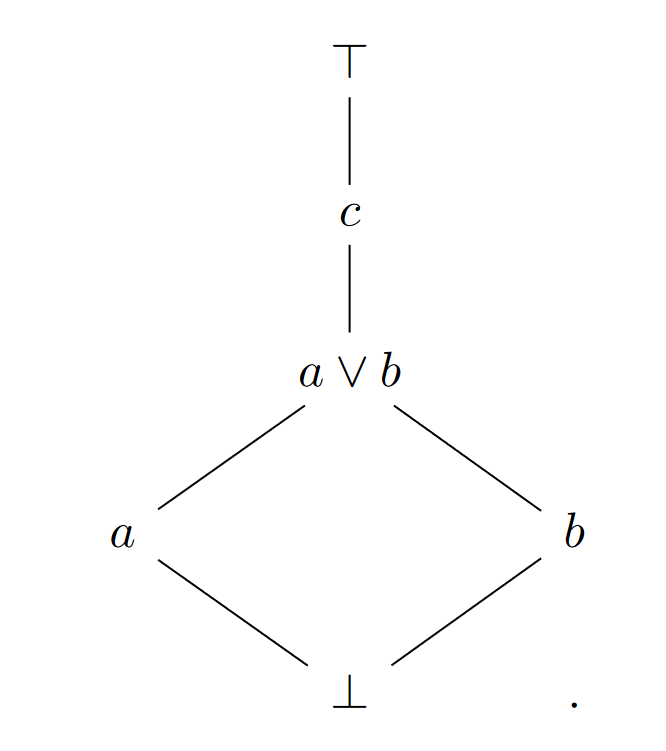
Classical vs Quantum Logic
In classical (Boolean) logic, a model would be a lattice homomorphism from to , the lattice of subsets of a set , while in quantum logic we use the lattice of subspaces of a vector space. The key characteristic of classical logic is the distributive property:
and its dual.
Note that any classical model of a theory also gives rise to a quantum model by taking the vector space with basis the set , and composing with the lattice homomorphism given by span.
Example: the double slit experiment
It's educational to consider an example of a non-classical quantum logic. Consider 3 events , , and (can be thought of as a particle passing through the first slit, passing through the second slit, and hitting the screen at a given point, respectively), whose corresponding propositions form the following non-distributive lattice (called ):
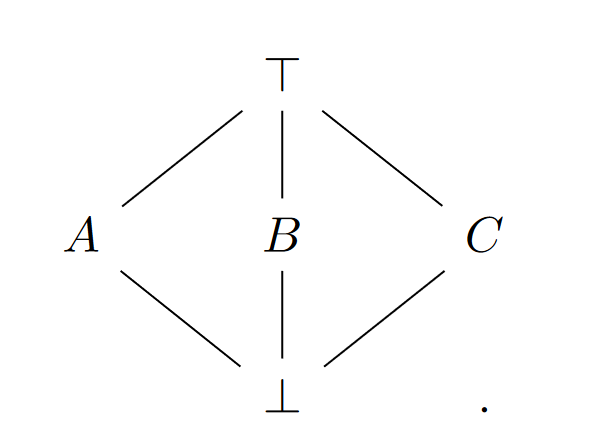
It is easy to see that cannot be represented as a lattice of subsets due to the failure of distributivity. However, we can model as three distinct lines in the lattice of subspaces of the plane.
Consistency in Quantum Logic
We call a theory consistent if it has a non-trivial (i.e. where ) model. Boolean consistency (or satisfiability) is well-know to be NP-hard, so it's natural to ask about the complexity of deciding consistency in the quantum setting.
One immediate necessary criterion for consistency can be seen as follows. If is a lattice homomorphism, then by taking the dimension of subspaces, we get a map satisfying the following properties:
- , and
- whenever
- .
We might wonder whether the existence of such a is sufficient.
Conjecture 2. Given a dimension function as above, there exists a linear representation of with dimensions as specified by .
If this conjecture were true, that would mean the existence of a polynomial time algorithm to check quantum satisfiability (since finding such a is a linear programming problem). As it turns out, the conjecture is false, which we show in Counterexample 2. Hence the proposed simple polynomial time algorithm to check quantum consistency doesn't work. Indeed, quantum consistency turns out to be unsolvable[1].
Lattice Theory Prerequisites
Modular lattices
Vector subspaces have the property that if and then . So any linear representation of the lattice would factor through the quotient lattice where if and we identify and . The resulting quotient lattice and the induced map would satisfy a stronger version of the properties 1-3 above, where in 2 we now have whenever . It turns out that lattices with such a function are exactly the modular lattices (with the additional property of every bounded chain being finite). These results are spelled out in point 7 and Theorem 9 of Chapter V in [Bir40[3]].
Thus Conjecture 2 boils down to whether these modular lattices always have non-trivial linear representations. This seems somewhat unlikely at first glance, since linear subspace lattices need to satisfy additional properties, e.g. the arguesian property (discussed further in the "Arguesian lattices" section), and indeed in Counterexample 9 we show that this is not the case.
Definition 3. For in a lattice, the quotient (also called the interval) is the sublattice
Definition 4. For any in a lattice we say the quotients and are projective (to each other). So being projective is the equivalence relation generated by these pairs of quotients.
Definition 5. A quotient is called prime if , but there's no such that .
Lemma 6. A modular lattice of finite length is simple (i.e., without proper congruence relations) if and only if all its prime quotients are projective (to each other). Note that being simple means having no proper non-trivial quotients.
Proof. This is Corollary 1 in Chapter V, Section 7 of [Bir40[3]]. We only need the simpler "if" direction here, which is fairly straightforward to see directly as follows. If is a congruence relation on , then implies , and the dual claim also holds. So if a certain quotient is annulled by (i.e. made equivalent) then so is every projective quotient.
Now assume is non-trivial, so for some . Then also . Since is finite length, there is some with prime (and ). Then by the above every prime quotient is annulled by , which in a finite length lattice implies that annuls everything. ◻
Arguesian lattices
Definition 7. A modular lattice is called arguesian if for any (),
implies
where ().
This is the lattice-theoretic formulation of Desargues' theorem, considering the incidence lattice of a projective space:
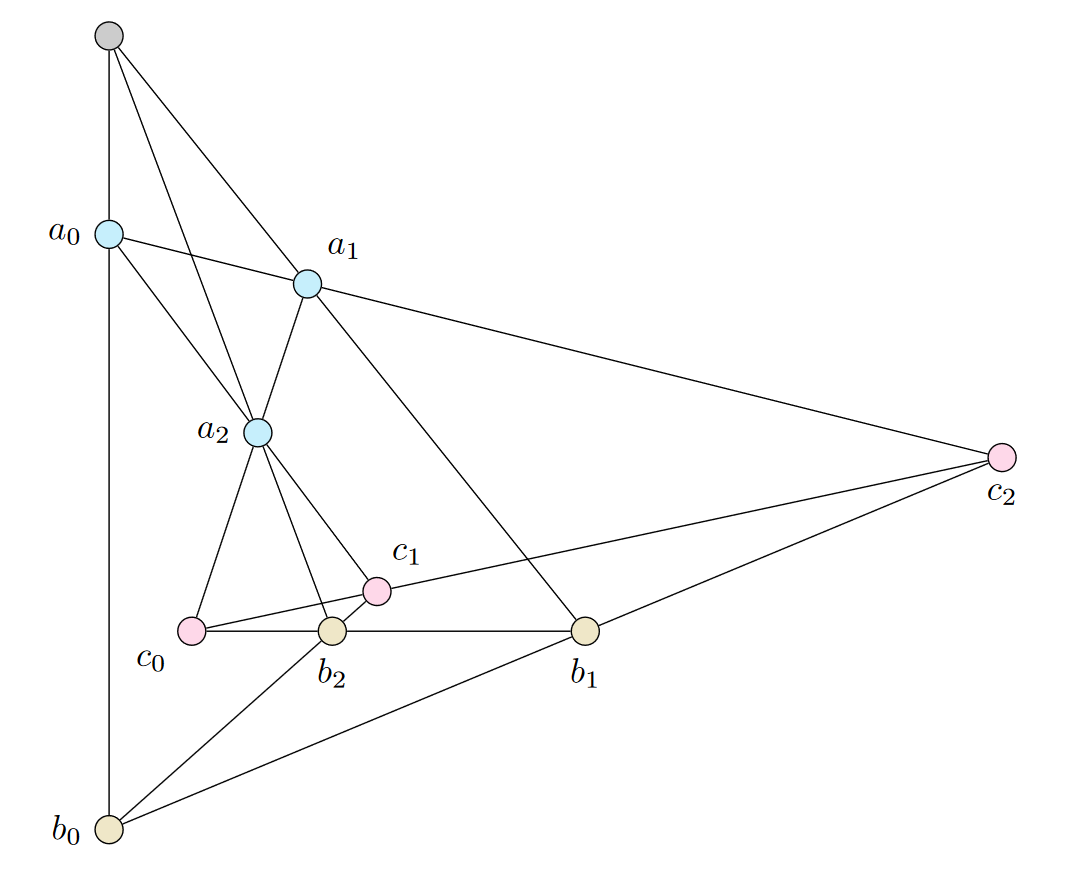
Lemma 8. For any ring , the lattice of submodules of a (left) -module is an arguesian lattice. In particular any sublattice of is also arguesian.
Proof. Let , be submodules such that the assumption in the arguesian property
is satisfied. Let . We want to show that . Let , so by definition
for , and . Now
so by (1) we have , i.e. for and . But then
and
so
as required. ◻
A Counterexample
Counterexample 9. Conjecture 2 fails for the incidence lattice of a finite non-Desarguesian projective plane. Note that the smallest such plane has points, which corresponds to a theory on propositional variables.
Proof. The lattice is modular (an explicit dimension function can be defined by , and for all points and lines). Being the incidence lattice of a non-Desarguesian plane, is not arguesian. This lattice also turns out to be simple (i.e. without any smaller non-trivial quotients), and so by Lemma 8 it cannot have a non-trivial linear representation. The fact that is simple follows from Lemma 6 after showing that all prime quotients are projective for this incidence lattice.
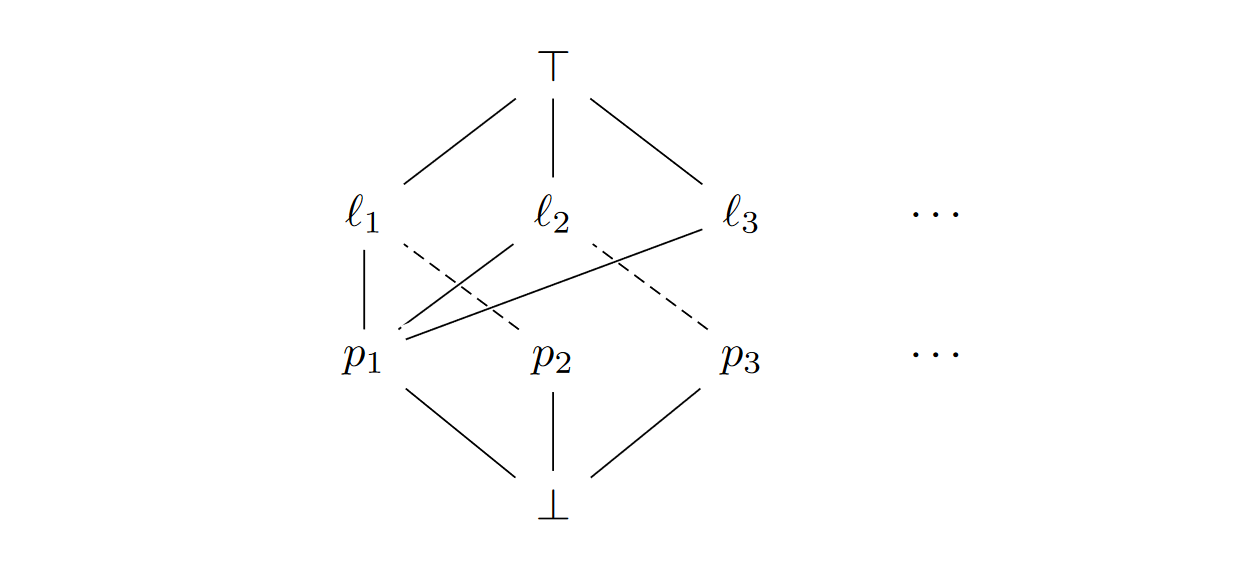
First consider a point in the projective plane, and let be the distinct lines through . Then by definition (using here to denote intervals projective to each other) , and for any . Since there are at least three lines through , this then implies all of , and are projective to each other for all by transitivity.

Now let be a point distinct from , and let be the line through and . Then from the above is projective to both and , which in turn are projective to and .
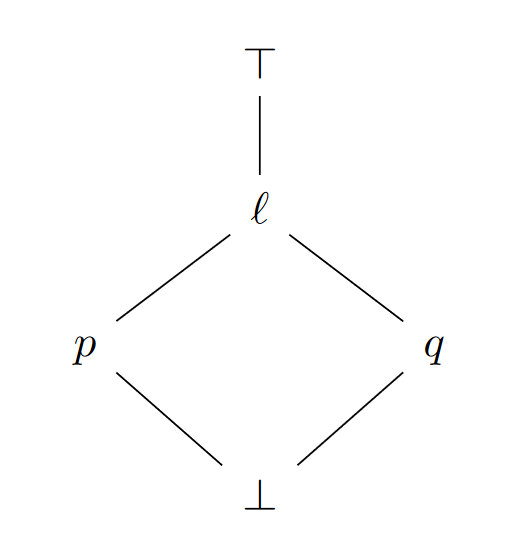
Putting all of these together, since any line contains at least one point, we can deduce that in fact all prime quotients are projective to each other in the incidence lattice. ◻
To construct a theory from Counterexample 9, we can introduce propositional variables corresponding to the points of the projective plane, corresponding to the lines , and let contain all the following:
- for
- for
- if the point lies on the line
- if is the line through and for
- if is the point of intersection of and for .
- ^
Christian Herrmann and Yasuyuki Tsukamoto and Martin Ziegler. On the consistency problem for modular lattices and related structures, 2016
- ^
Christian Herrmann and Martin Ziegler. Computational Complexity of Quantum Satisfiability, 2010
- ^
[Bir40] Garrett Birkhoff. Lattice Theory. American Mathematical Society, New
York, 1940
0 comments
Comments sorted by top scores.